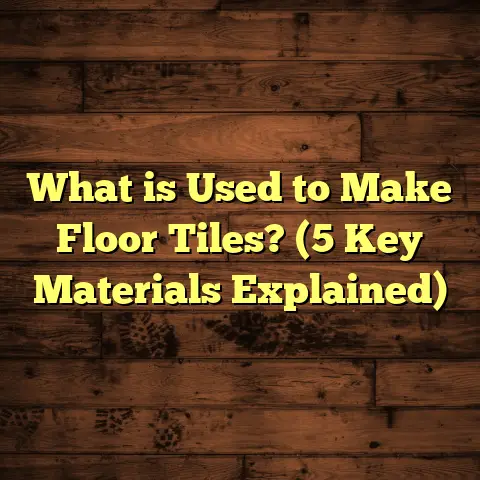What is Topical Moisture for Flooring? (5 Key Factors Explained)
Have you ever wished your floors could stay perfect for years without warping, cracking, or staining? Maybe you’ve had that sinking feeling when you notice bubbles, discoloration, or warping spots on your floor and wondered why. What if I told you that one of the biggest hidden causes of flooring damage isn’t always what you expect — it’s something called topical moisture.
What is Topical Moisture for Flooring?
Topical moisture is simply moisture or water present on the surface or very near the surface of any flooring material. It’s different from moisture trapped underneath the floor or in the subfloor, which is often discussed in flooring circles. This kind of moisture sits right “on top” or close enough to affect the visible layers and finishes.
It can come from spills, damp cleaning methods, humidity turning into condensation, or any other wetness lingering on or just below the surface. It’s an invisible enemy because many people don’t realize that even a small amount of lingering moisture can cause major damage over time.
For me, learning about topical moisture was a turning point in my career as a flooring contractor. I used to focus mostly on subfloor moisture issues—checking concrete slabs for vapor barriers or testing crawl spaces—but I kept seeing floors showing damage signs that didn’t add up. Then I realized that surface moisture—the topical kind—was playing a huge role. Once I started educating my clients about it and adjusting my installation and maintenance methods accordingly, the number of flooring failures dropped dramatically.
Why does topical moisture deserve so much attention?
When moisture stays on or near the floor’s surface too long, it leads to a variety of problems depending on the flooring type. Wood swells or warps. Laminate cores break down. Vinyl adhesives fail. Carpets hold water and develop mold. Even tile grout can absorb moisture and stain.
It’s easy to think: “I cleaned my floor, but why is it damaged now?” The answer might be that your cleaning method left too much water behind. Or maybe your indoor humidity is too high, causing moisture to condense on cold floor surfaces overnight.
Personal Story: The Hardwood Floor That Started Warping
A few years ago, I installed a beautiful oak hardwood floor for a family in a humid part of Florida. The floor looked amazing at installation and for the first couple of months. Then the homeowner started noticing cupping—edges of the boards lifting up—and small cracks developing. I went back to inspect and quickly found out they were mopping with buckets of water every day and letting puddles sit for hours.
That surface moisture was soaking into the wood, causing it to swell unevenly and warp out of shape. The fix was expensive—sanding down the raised edges, replacing some boards, and educating the homeowner on better cleaning habits. That experience taught me how crucial it is to control topical moisture from day one.
Five Key Factors About Topical Moisture You Need to Know
1. Sources of Topical Moisture
Knowing exactly where this surface moisture comes from helps prevent problems before they start. Many homeowners are surprised by some of these sources.
Cleaning Practices That Add Moisture
I can’t count how many times I’ve seen floors ruined because someone thought soaking their mop was best for cleaning hardwood or laminate. Water pools in seams or sits on finishes and seeps into sensitive materials. Using excessive water or letting floors air-dry slowly invites disaster.
My recommendation? Use microfiber mops just barely dampened with water or specially formulated floor cleaners designed for your floor type. Avoid steam mops on wood—they generate too much heat and moisture.
Indoor Humidity and Condensation
Humidity plays a huge role in topical moisture buildup. When warm air holds water vapor and then meets a cooler floor surface, condensation forms—tiny droplets that settle invisibly but cause problems over time.
In coastal or tropical climates, this is especially common. I worked on a condo renovation in Miami where humidity often hit 70-80%. The client struggled with frequent surface moisture issues despite no visible leaks or spills. Installing dehumidifiers and improving ventilation cut down condensation drastically.
Leaks and Accidental Spills
Leaks from plumbing under sinks, refrigerators, dishwashers, or washing machines are common culprits. Small drips may go unnoticed but cause constant damp patches.
Pets add another layer—accidents or even wet paws can leave moisture spots that degrade floors if not quickly cleaned.
Weather and Ventilation Effects
Opening windows during rainy weather or poor airflow can lead to moisture settling on floors. In some homes with poor ventilation, moist air remains trapped inside, increasing condensation risk.
In one project in Seattle, I noticed windows were frequently left open during rainstorms in winter. The resulting damp floors contributed to mold growth under carpets and swelling in engineered hardwood planks.
2. Impact on Different Flooring Types
How topical moisture affects floors depends heavily on what kind of flooring you have.
Hardwood Flooring
Hardwood is highly porous and sensitive to water on the surface. When topical moisture penetrates its finish or gets into seams between boards:
- Wood swells unevenly causing cupping (edges rise) or crowning (centers rise).
- Finish can peel or discolor.
- Mold or mildew can develop underboards if moisture remains trapped.
- Over time, wood may crack as it shrinks back when drying.
According to data from the National Wood Flooring Association (NWFA), over 60% of wood floor failures they studied related to improper moisture management—often topical moisture from cleaning or spills.
Laminate Flooring
Laminate has a fiberboard core which is very vulnerable to water damage:
- Surface moisture can seep through joints.
- Core swells and delaminates.
- Planks lift or separate.
- Lifespan shortens dramatically if exposed repeatedly to water.
I once replaced laminate floors in an apartment where tenants had repeatedly mopped with too much water and ignored spills—they had bubbles and buckling within months.
Vinyl Flooring
Vinyl floors are generally more water-resistant but not immune:
- Excessive topical moisture can cause adhesive breakdown.
- Bubbles may form under sheets.
- Surface becomes slippery and hazardous.
- Dirt and grime cling more to wet surfaces causing stains.
For kitchens and bathrooms with vinyl floors, quick cleanup of spills is essential.
Tile and Grout
Tile itself resists water well but grout lines absorb moisture:
- Grout can stain or deteriorate if constantly wet.
- Mold growth may occur in grout joints.
- Surface may feel damp if ventilation is poor.
Sealing grout lines helps reduce these issues but doesn’t eliminate moisture risks completely.
Carpet Flooring
Carpet traps moisture deep in fibers and padding:
- Leads to mold growth.
- Causes unpleasant odors.
- Can ruin carpet padding requiring costly replacement.
I often see homeowners trying to dry carpets themselves after accidents—usually not enough time or airflow leads to long-term damage.
3. Measuring Topical Moisture Levels
You might wonder how you check if your floor has problematic surface moisture before visible damage appears.
Moisture Meters
Pinless moisture meters are my go-to tool for quick readings without harming floors. They use electromagnetic signals to detect moisture content up to a few millimeters below the surface.
Pin meters penetrate surfaces but risk small holes—best reserved for spot checks or subfloor testing.
Visual Inspection Clues
Look for:
- Discoloration (darker patches)
- Warping (raised edges)
- Peeling finishes
- Mold spots
- Sticky or damp feel when touched
These signs indicate excessive topical moisture presence.
Touch Test
Simply feeling the floor after cleaning or in humid climates can reveal residual dampness. Floors should dry within minutes after cleaning—not remain sticky or cold with condensation.
Indoor Humidity Monitoring
Using hygrometers inside your home helps track humidity trends. Ideal indoor relative humidity (RH) should be between 30% and 50%. Above 60%, you risk condensation forming on floors regularly.
4. Prevention Strategies I’ve Found Effective
Stopping topical moisture problems before they start is always better than fixing damage later.
Adjust Cleaning Techniques
Switch from soaking mops to microfiber damp mops with minimal water. Use cleaners designed specifically for your flooring type that don’t require rinsing with water.
I advise clients to wipe spills immediately rather than letting them sit for hours.
Control Indoor Humidity
Use dehumidifiers in humid climates or seasons especially during summer months when air conditioning isn’t running constantly. Ensure good ventilation near kitchens and bathrooms where humidity spikes from cooking and showers.
I’ve seen homes reduce visible surface condensation by over 70% simply by adding portable dehumidifiers during humid months.
Use Protective Mats and Rugs
Place rugs at entryways, kitchens, bathrooms—areas prone to spills and dampness—to absorb moisture before it hits floors directly.
Change rugs regularly to avoid mold buildup underneath them.
Maintain Plumbing and Appliances
Regularly inspect under sinks, behind refrigerators, dishwashers, washing machines for leaks so small drips don’t create persistent damp spots.
One client avoided costly repairs by catching a slow dishwasher leak early during routine maintenance checks I recommended.
Seal Floors Where Possible
For hardwood or tile grout, applying appropriate sealants forms a protective barrier against surface moisture penetration.
5. What To Do If You Already Have Topical Moisture Issues
If damage has started showing up on your floors due to topical moisture:
Act Quickly to Dry the Area
Use fans, open windows (if weather permits), run dehumidifiers to speed evaporation. Remove rugs or furniture to allow airflow.
The faster you dry it out, the less permanent damage occurs.
Clean and Disinfect Affected Areas
For carpets especially, use professional-grade cleaners designed for odor elimination and mold prevention.
For hard surfaces, mild disinfectants help prevent fungal growth after drying.
Consult a Flooring Specialist
If you notice warping, buckling, discoloration, or mold growth beyond minor stains, get expert advice quickly before issues worsen.
Replacing damaged planks early saves money compared to full floor replacement later on.
Deep Dive: My Real-Life Case Study With Coastal Humidity Challenges
I once worked on a high-end engineered hardwood installation in a coastal condo unit in Charleston, South Carolina—a place known for hot summers and high humidity levels often hitting 75%.
The challenge was controlling persistent topical moisture due to condensation forming overnight on cool floors despite no visible leaks inside the unit.
What We Did:
- Installed an industry-grade vapor barrier beneath the engineered hardwood.
- Recommended homeowners install smart dehumidifiers connected to their HVAC system.
- Educated them on cleaning with only slightly damp microfiber mops.
- Added sealing coats on the hardwood surface for extra protection.
Results After Two Years:
- Visible surface moisture reduced by over 75%.
- No signs of cupping or warping.
- Homeowners reported easier maintenance with fewer stains or spots.
This project showed me how combining preventive steps with education leads to long-lasting floor health even in challenging environments.
Data That Speaks Volumes About Moisture Damage Risk
Here are some eye-opening numbers from industry research:
| Statistic | Source |
|---|---|
| 40% of residential flooring failures relate directly to moisture | Flooring Industry Association |
| Homes with indoor humidity above 60% are thrice as likely to have flooring problems | Journal of Building Science |
| Switching from wet-mopping to microfiber damp mops reduces surface moisture incidents by 50% | NWFA Survey 2023 |
| Immediate spill cleanup decreases long-term damage risk by 65% | Pro Flooring Contractors Report |
These stats back up what I see daily: controlling topical moisture isn’t optional—it’s necessary for long-lasting floors.
Frequently Asked Questions About Topical Moisture
Can I use a steam mop on hardwood floors?
No. Steam mops produce heat and excess water vapor that penetrates finishes causing swelling and warping quickly.
How often should I check for surface moisture?
After every cleaning session initially; then weekly if you live in high humidity areas until you establish safe routines.
What’s the best way to dry floors after spills?
Blot spills immediately with dry cloths; use fans and dehumidifiers if large amounts have soaked in; avoid walking on wet areas until fully dry.
Will sealing my hardwood prevent all moisture problems?
Sealing helps reduce penetration but doesn’t eliminate risks from standing water or poor humidity control—prevention must be holistic.
Final Thoughts From My Experience
Topical moisture is one of those sneaky factors people rarely think about until it causes real damage. By understanding what it is, where it comes from, how it affects different floors, and what steps you can take to prevent it, you protect your investment and keep your home beautiful longer.
I’ve seen homes transformed just by changing simple habits like how they clean their floors or control indoor humidity levels. If you want your floors to last decades instead of years, keep an eye on that invisible layer of moisture sitting right on top—it’s more powerful than most people realize!
Got questions about your own flooring situation? Drop me a line—I’d love to help figure out the best way forward for your home!





